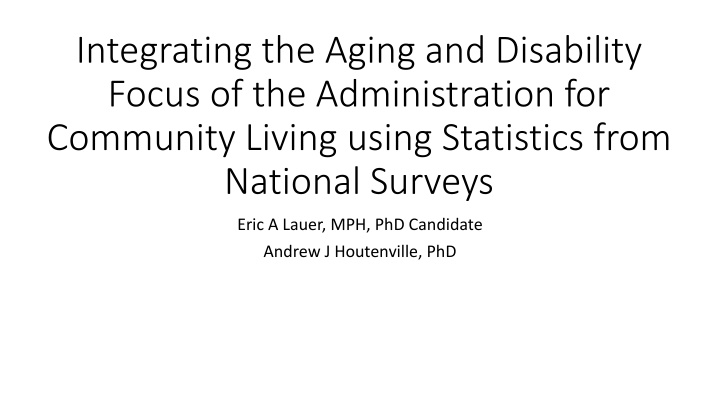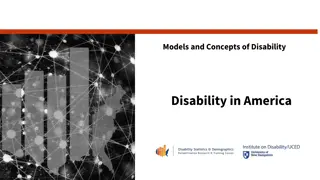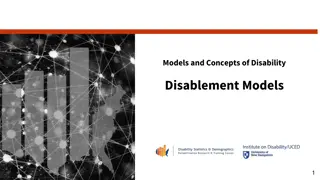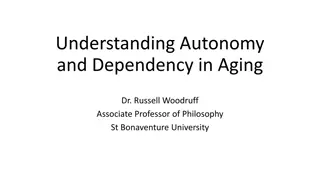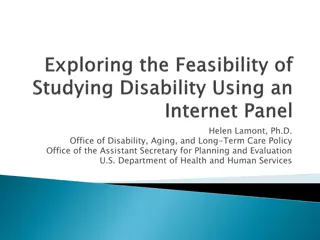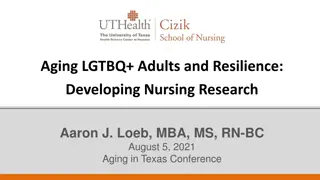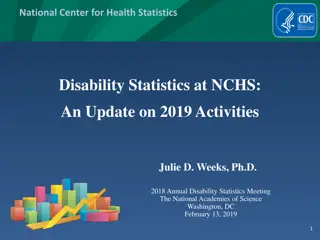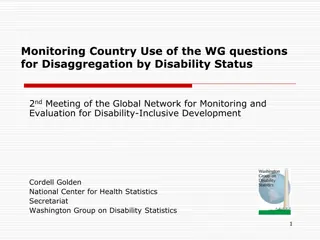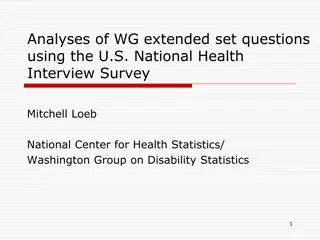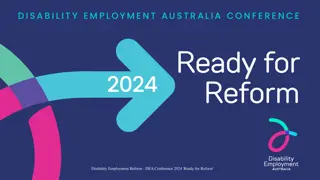Integrating Aging and Disability Focus: National Survey Insights
Shifting age structures in the United States highlight the growing population of older adults at risk of disability. National surveys help identify subpopulations at risk, utilizing standardized disability questions. Explore statistics and trends from surveys to inform strategies for supporting aging and disability integration.
Download Presentation

Please find below an Image/Link to download the presentation.
The content on the website is provided AS IS for your information and personal use only. It may not be sold, licensed, or shared on other websites without obtaining consent from the author.If you encounter any issues during the download, it is possible that the publisher has removed the file from their server.
You are allowed to download the files provided on this website for personal or commercial use, subject to the condition that they are used lawfully. All files are the property of their respective owners.
The content on the website is provided AS IS for your information and personal use only. It may not be sold, licensed, or shared on other websites without obtaining consent from the author.
E N D
Presentation Transcript
Integrating the Aging and Disability Focus of the Administration for Community Living using Statistics from National Surveys Eric A Lauer, MPH, PhD Candidate Andrew J Houtenville, PhD
Financial Disclosure None This effort is part of the Rehabilitation Research and Training Center on Disability Statistics and Demographics (StatsRRTC) is funded by the U.S. Department of Health and Human Services Administration For Community Living National Institute on Disability, Independent Living, and Rehabilitation Research (NIDILRR) - Rehabilitation Research and Training Centers (RRTCs) Program under grant number 90RT5022-02-01, from 2013 - 2018. The information developed by the StatsRRTC does not necessarily represent the policy of the Department of Health and Human Services, and you should not assume endorsement by the Federal Government.
Background Age structure of the United States has been shifting Older population (ages 65 and over) increasing in size and average age Increased by more than 50 percent since 1980 Greatest risk of disability and greatest increase in risk of disability over time Increasing older population with disabilities Risk of rapid expansion over next two decades Baby boomers began entering this population in 2011 Need to identify subpopulations within this group at greatest risk of experiencing a disability National surveys and standardized disability questions
Self-Report Difficulty Questions Intended to cover six disability types: Hearing difficulty Deaf or having serious difficulty hearing. Vision difficulty Blind or having serious difficulty seeing, even when wearing glasses. Cognitive difficulty Because of a physical, mental, or emotional problem, having difficulty remembering, concentrating, or making decisions. Ambulatory difficulty Having serious difficulty walking or climbing stairs. Self-care difficulty Having difficulty bathing or dressing. Independent living difficulty Because of a physical, mental, or emotional problem, having difficulty doing errands alone such as visiting a doctor s office or shopping. United States Census Bureau, American Community Survey, History of the Disability Questions: https://www.census.gov/people/disability/methodology/acs.html 4
Percentage of People in the United States Ages 65 and Over with Disabilities 5.15% 5.2% 5.07% 5.1% 5.0% 4.86% 4.9% Percent 4.78% 4.8% 4.72% 4.71% 4.7% 4.6% 4.5% 4.4% 2009 2010 2011 2012 2013 2014 Year Estimates from the Annual Disability Statistics Compendium based on data from American Factfinder, 2009-2014 American Community Survey
Introduction Statistics for people with disabilities are difficult to find National surveys and federal agencies and reports provide data for surveillance and policy Information for specific groups (e.g. people ages 65 and over) is not centralized or readily available Reports are often produced using one data source U.S. Census Bureau produces reports such as the Older Americans With a disability: 2008-2012, using the American Community Survey The Annual Disability Statistics Compendium combines disability statistics into one report
Annual Disability Statistics Compendium Combines statistics from national data sources and reports and federal agencies: American Community Survey Current Population Survey Behavioral Risk Factor Surveillance System Centers for Medicaid and Medicare Services Office of Special Education Programs Social Security Administration Rehabilitation Services Administration Includes approximately 140 tables across 14 topics with disability-related statistics Recently expanded content for people ages 65 and over
Annual Disability Statistics Compendium Topics with people ages 65 and over include: Prevalence Disability type Employment Poverty Veterans Health Insurance Medicaid Medicare Social Security Over 100 tables were added or expanded to include people ages 65 and over in 2015
Annual Disability Statistics Compendium Statistics shows the burden of disability among the aging population Approximately 40% have one or more disabilities Approximately 66% have an ambulatory disability (e.g. difficulty walking) Approximately 50% have an independent living disability (e.g. going to the doctor s office, doing errands) Statistics show disparities and inequities for the aging population: 3+ times as likely to report disabilities, compared to people ages 18 to 64 2 times as likely to live in poverty with a disability, compared to people ages 18 to 64 with disabilities Veterans 3 times as likely to report disabilities, compared to veterans ages 18 to 64
Percentage of People in the United States Employed with Work Limitations, by Age 20.0% Ages 16-64 19.5% 18.9% Ages 65 and Over 18.5% 19.0% 18.5% 18.3% 18.5% 18.0% 17.4% Percent 18.2% 17.1% 17.5% 17.6% 17.0% 17.3% 17.0% 16.5% 16.6% 16.0% 15.2% 15.5% 15.0% 2009 2010 2011 2012 2013 2014 Year Estimates from the Annual Disability Statistics Compendium based on data from the 2009-2014 Current Population Survey-Annual Social and Economic Supplement.
Conclusion Multiple data sources create a powerful picture of the difficulties the aging population experiences National surveys have samples large enough to study subpopulations of the aging population American Community Survey, 2015 Sample Current Population Survey-Annual Social and Economic Supplement, 2015 Sample The Annual Disability Statistics Compendium can be used by researchers, agencies, organizations and advocates to support and plan for the aging population Reports and statistics can be tailored to agency and advocate needs
Limitations Cross-sectional nature of national surveys and reports Age of onset Duration of disability Underlying unweighted sample age
Next Steps Additions to the Annual Disability Statistics Compendium Gender Employment policy Website National survey and report data used to produce the Annual Disability Statistics Compendium The Compendium will be available for users to modify Standardized national and state reports Report wizard with tables and figures for custom reports
Contact Information Eric Lauer eric.lauer@unh.edu Institute on Disability University of New Hampshire College of Health and Human Services Durham, NH
